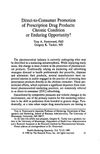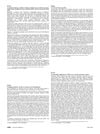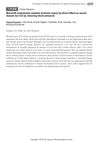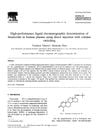Search
for
Sort by
Research
180-210 / 1000+ results
research Patient-Reported Outcomes and Safety of Direct-to-Consumer Teledermatology for Finasteride in Male Androgenetic Alopecia
Most men using teledermatology for hair loss treatment saw improved hair and self-esteem, with some experiencing side effects.
research Direct-To-Consumer Teledermatology’s Limitations May Be Addressed With Greater In-Person Care Synergy
Combining online and in-person dermatology care can improve quality and access.
research Comparison of Sensitivity Patterns of Direct Immunofluorescence on Perilesional Skin and Plucked Hair in Pemphigus Vulgaris
Plucked hair can help diagnose pemphigus vulgaris early.

research Direct Hair Growth Promoting Effects of Mycophenolic Acid
Mycophenolic acid may help hair grow by activating pathways important for hair growth.

research Direct-To-Consumer Promotion of Prescription Drug Products
Drug companies were interested in advertising directly to consumers to make back their money, but most didn't think it would help and were concerned about negative effects.
research Online Traffic Analysis of Direct-to-Consumer Websites for Hair Loss Treatment and Characterization of Finasteride Patients on a Platform in Germany: A Potential Paradigm Shift in the Treatment of Androgenetic Alopecia
More people are using online platforms for hair loss treatment due to convenience and privacy.

research The Direct Inhibitory Effect of Dutasteride or Finasteride on Androgen Receptor Activity Is Cell Line Specific
Dutasteride and finasteride affect different cell types differently.

research A Direct Link Between Prss53, Hair Curvature, and Skeletal Dysplasia
The gene Prss53 affects hair shape and bone development in rabbits.

research Direct Observation of Hair Components Involved in Formation of Permanent Waves
Microfibrils are key for permanent waves, and hydrolyzed keratin improves wave formation and hair condition.

research The Current Landscape for Direct-to-Consumer Genetic Testing: Legal, Ethical, and Policy Issues
The document concludes that the fast-growing direct-to-consumer genetic testing market lacks sufficient regulation, posing risks to consumers due to questionable test quality and accuracy.
research LHX2 Is a Direct NF-κB Target Gene That Promotes Primary Hair Follicle Placode Down-Growth
LHX2 is essential for hair follicle development, controlled by NF-κB and TGFβ2 signaling.

research p53 Is a Direct Transcriptional Repressor of Keratin 17: Lessons from a Rat Model of Radiation Dermatitis
The protein p53 directly reduces the production of Keratin 17, a skin and hair protein, in rats with radiation dermatitis.

research Pretrimmed Versus Direct Nonshaven Follicular Unit Extraction
Both pretrimmed and direct nonshaven methods are effective for hair transplants; pretrimmed takes longer but yields denser, longer hair.

research High-Throughput and Direct Measurement of Androgen Levels Using Turbulent Flow Chromatography Liquid Chromatography-Triple Quadrupole Mass Spectrometry to Discover Chemicals That Modulate Dihydrotestosterone Production in Human Prostate Cancer Cells
Researchers found four natural compounds that can change DHT levels in prostate cancer cells.

research Dermatologic Applications of Direct-to-Consumer Genomic Analysis
Living near more dermatologists and using certain cancer screening tests lowers the chance of being diagnosed with advanced skin cancer.

research Dihydrotestosterone Induces p27 Degradation via Direct Binding with SKP2 in Ovarian and Breast Cancer
Dihydrotestosterone causes p27 protein breakdown in ovarian and breast cancer cells by binding with SKP2.
research Stat3 Partly Inhibits Cell Proliferation Via Direct Negative Regulation of FST Gene Expression
The protein STAT3 slows down cell growth by blocking the FST gene, which affects hair development in sheep.
research Simvastatin Reduces Autoimmune Alopecia Through Direct Action on T Lymphocytes
Simvastatin helps hair regrowth in autoimmune alopecia by directly affecting T cells.

research Minoxidil Suppressed Cerebral Ischemic Injury by Direct Effect on Neural Tissues but Not by Reducing Blood Pressure
Minoxidil protects brain tissue directly, not by lowering blood pressure.
research Visible Red Light Enhances Physiological Anagen Entry In Vivo And Has Direct And Indirect Stimulatory Effects In Vitro
Red light promotes hair growth by directly stimulating hair cells and improving cell communication.

research High-Performance Liquid Chromatographic Determination of Finasteride in Human Plasma Using Direct Injection with Column Switching
New method detects finasteride in plasma quickly and accurately without clean-up.

research Dopamine Is a Novel, Direct Inducer of Catagen in Human Scalp Hair Follicles In Vitro
Dopamine stops hair growth and pigment production in human scalp hair follicles.

research Epidermal Cells Expressing Putative Cell Markers in Nonglabrous Skin Near the Distal End of the Arrector Pili Muscle
Certain skin cells near the base of hair muscles may help renew and stabilize skin, possibly affecting skin disorder understanding.

research Economic Burden of Alopecia Areata: A Study of Direct and Indirect Cost in Japan Using Real-World Data
Alopecia areata causes a significant economic burden in Japan, mainly due to productivity loss.
research Anabolic and Metabolic Effects of Testosterone and Other Androgens: Direct Effects and Role of Testosterone Metabolic Products
Testosterone and its metabolites have varied effects on different body systems, especially during puberty.
research Cross-Sectional Cost Analysis of Finasteride for Androgenetic Alopecia via Direct-to-Consumer Pharmacies Compared to Online Wholesale Pharmacies
research Social Media for Arthritis-Related Comparative Effectiveness and Safety Research and the Impact of Direct-to-Consumer Advertising
Social media can help compare the effectiveness and safety of new arthritis medications.

research Tinea Captitis Due to Microsporum Ferrugineum: A Case of Unusual Laboratory Finding on Direct Microscopic Examination of Infected Hairs and Skin Lesions
Unusual fungal structures were found in a boy's scalp infection, successfully treated with medication.

research Astilbin Activates the Reactive Oxidative Species/PPARγ Pathway to Suppress Effector CD4+ T Cell Activities via Direct Binding With Cytochrome P450 1B1
Astilbin can potentially calm overactive immune responses, like in Type 1 Diabetes, by suppressing certain cell activities and reducing inflammation.